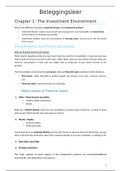Samenvatting
Summary Beleggingsleer
Uitgebreide samenvatting van het vak beleggingsleer gegeven door Michael Frömmel op basis van zijn boek 'Finance 1: Portfolio Theory and Management'. Naar de les gaan of het boek doornemen is overbodig met deze samenvatting. Het is hét hulpmiddel bij uitstek om een schitterend examen af te leggen.
[Meer zien]




